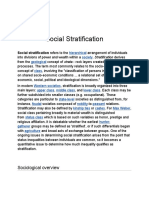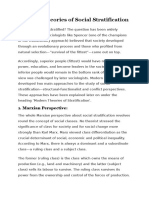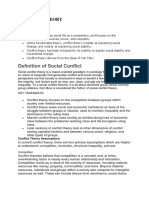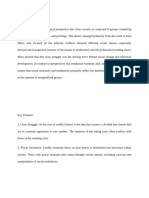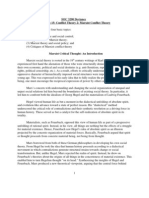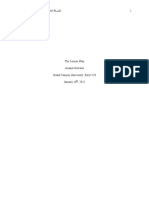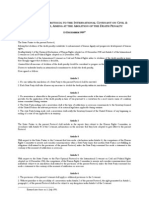STRAFICATION!!!
STRAFICATION!!!
Uploaded by
Wideyo VaughnkerzCopyright:
Available Formats
STRAFICATION!!!
STRAFICATION!!!
Uploaded by
Wideyo VaughnkerzCopyright
Available Formats
Share this document
Did you find this document useful?
Is this content inappropriate?
Copyright:
Available Formats
STRAFICATION!!!
STRAFICATION!!!
Uploaded by
Wideyo VaughnkerzCopyright:
Available Formats
Social stratification From Wikipedia, the free encyclopedia Sociology Social Network Analysis diagram Portal Theory History
y Positivism Antipositivism Functionalism Conflict theory Middle-range Mathematical Critical theory Socialization Structure and agency Research methods Quantitative Qualitative Historical Computational Ethnographic Topics Subfields Cities Class Crime Culture Deviance Demography Education Economy Environment Family Gender Health Industry Internet Knowledge Law Medicine Politics Mobility Race and ethnicity Rationalization Religion Science Secularization Social networks Social psychology Stratification Categories Lists Journals Sociologists Article index Outline v d e In sociology the social stratification is a concept of class, involving the "cla ssification of persons into groups based on shared socio-economic conditions ... a relational set of inequalities with economic, social, political and ideologic al dimensions."[1] In modern Western societies, stratification is broadly organized into three main layers: upper class, middle class, and lower class. Each class may be further s ubdivided into smaller classes (e.g. occupational).[2] These categories are part icular to state-based societies as distinguished from, for instance, feudal soci eties composed of nobility-to-peasant relations. Stratification may also be defi ned by kinship ties or castes. For Max Weber, social class pertaining broadly to material wealth is distinguished from status class which is based on such varia bles as honor, prestige and religious affiliation. Talcott Parsons argued that t he forces of societal differentiation and the following pattern of institutional ized individualization would strongly diminish the role of class (as a major str atification factor) as social evolution went along. It is debatable whether the earliest hunter-gatherer groups may be defined as 'stratified', or if such diffe rentials began with agriculture and broad acts of exchange between groups. One o f the ongoing issues in determining social stratification arises from the point that status inequalities between individuals are common, so it becomes a quantit ative issue to determine how much inequality qualifies as stratification.[3] Contents [hide]
1 Sociological overview 1.1 Karl Marx 1.2 Max Weber 2 Anthropological overview 2.1 Kinship-orientation 3 Social impact 4 Three characteristics of stratified systems 5 See also 6 References 7 External links [edit] Sociological overview The concept of social stratification is interpreted differently by the various t heoretical perspectives of sociology. Proponents of action theory have suggested that since social stratification is commonly found in developed societies, hier archy may be necessary in order to stabilize social structure. Talcott Parsons, an American sociologist, asserted that stability and social order are regulated, in part, by universal value although universal values were not identical with " consensus" but could as well be the impetus for ardent conflict as it had been m ultiple times through history. Parsons never claimed that universal values in an d by themselves "satisfied" the functional prerequisites of a society, indeed, t he constitution of society was a much more complicated codification of emerging historical factors. The so-called conflict theories, such as Marxism, point to t he inaccessibility of resources and lack of social mobility found in stratified societies. Many sociological theorists have criticized the extent to which the w orking classes are unlikely to advance socioeconomically; the wealthy tend to ho ld political power which they use to exploit the proletariat intergenerationally . Theorists such as Ralf Dahrendorf, however, have noted the tendency toward an enlarged middle-class in modern Western societies due to the necessity of an edu cated workforce in technological and service economies. Various social and polit ical perspectives concerning globalization, such as dependency theory, suggest t hat these effects are due to the change of workers to the third world. yes--192. 248.24.10 (talk) 04:22, 29 December 2011 (UTC) [edit] Karl Marx Main articles: Marxism, Historical materialism, and Base and superstructure In Marxist theory, the capitalist mode of production consists of two main econom ic parts: the substructure and the Superstructure. The base comprehends the rela tions of production employer-employee work conditions, the technical division of labour, and property relations into which people enter to produce the necessiti es and amenities of life. In the capitalist system, the ruling classes own the m eans of production, which essentially includes the working class itself as they only have their own labour power ('wage labour') to offer in order to survive. T hese relations fundamentally determine the ideas and philosophies of a society, constituting the superstructure. A temporary status quo is achieved by various m ethods of social control employed, consciously or unconsciously, by the bourgeoi sie in the course of various aspects of social life. Through the ideology of the ruling class, false consciousness is promoted both through ostensibly political and non-political institutions, but also through the arts and other elements of culture. Marx believed the capitalist mode would eventually give way, through i ts own internal conflict, to revolutionary consciousness and the development of egalitarian communist society. According to Marvin Harris[4] and Tim Ingold,[5] Lewis Henry Morgan's accounts o f egalitarian hunter-gatherers formed part of Karl Marx and Engels's inspiration for communism. Morgan spoke of a situation in which people living in the same c ommunity pooled their efforts and shared the rewards of those efforts fairly equ ally. He called this "communism in living." But when Marx expanded on these idea
s, he still emphasized an economically oriented culture, with property defining the fundamental relationships between people.[6] Yet, issues of ownership and pr operty are arguably less emphasized in hunter-gatherer societies.[7] This, combi ned with the very different social and economic situations of hunter-gatherers m ay account for many of the difficulties encountered when implementing communism in industrialized states. As Ingold points out: "The notion of communism, remove d from the context of domesticity and harnessed to support a project of social e ngineering for large-scale, industrialized states with populations of millions, eventually came to mean something quite different from what Morgan had intended: namely, a principle of redistribution that would override all ties of a persona l or familial nature, and cancel out their effects."[5] [edit] Max Weber Main articles: Three-component theory of stratification and Tripartite classific ation of authority Max Weber was strongly influenced by Marx's ideas, but rejected the possibility of effective communism, arguing that it would require an even greater level of d etrimental social control and bureaucratization than capitalist society. Moreove r, Weber criticized the dialectical presumption of proletariat revolt, believing it to be unlikely.[8] Instead, he developed the three-component theory of strat ification and the concept of life chances. Weber supposed there were more class divisions than Marx suggested, taking different concepts from both functionalist and Marxist theories to create his own system. He emphasized the difference bet ween class, status, and power, and treated these as separate but related sources of power, each with different effects on social action. Working at half a centu ry later than Marx, Weber claimed there to be in fact four main classes: the upp er class, the white collar workers, the petite bourgeoisie, and the manual worki ng class. Weber's theory more-closely resembles modern Western class structures, although economic status does not seem to depend strictly on earnings in the wa y Weber envisioned. Weber derived many of his key concepts on social stratification by examining the social structure of Germany. He noted that contrary to Marx's theories, stratif ication was based on more than simply ownership of capital. Weber examined how m any members of the aristocracy lacked economic wealth yet had strong political p ower. Many wealthy families lacked prestige and power, for example, because they were Jewish. Weber introduced three independent factors that form his theory of stratification hierarchy; class, status, and power: Class: A person's economic position in a society. Weber differs from Marx in that he does not see this as the supreme factor in stratification. Weber noted how managers of corporations or industries control firms they do not own; Marx w ould have placed such a person in the proletariat. Status: A person's prestige, social honor, or popularity in a society. Weber noted that political power was not rooted in capital value solely, but also in one's individual status. Poets or saints, for example, can possess immense influ ence on society with often little economic worth. Power: A person's ability to get their way despite the resistance of others. For example, individuals in state jobs, such as an employee of the Federal Bure au of Investigation, or a member of the United States Congress, may hold little property or status but they still hold immense power.[9] [edit] Anthropological overview Anthropology Fields Archaeology Biological anthropology Cultural anthropology Linguistic anthropology
Social anthropology Frameworks Applied anthropology Ethnography and Ethnology Participant observation Qualitative methods Holism Cultural relativism Key concepts Culture Society Prehistory Evolution Kinship and descent Marriage Family Material culture Gender Race Ethnicity Functionalism Colonialism Ethnocentrism Postcolonialism Areas and subfields Anthropology of religion Biocultural anthropology Cognitive anthropology Ecological anthropology Economic anthropology Evolutionary anthropology Forensic anthropology Media anthropology Medical anthropology Palaeoanthropology Transpersonal anthropology Urban anthropology Visual anthropology Related articles Sociology Prehistory History of anthropology Outline of anthropology Category:Anthropologists v d e Anthropologists have found that social stratification is not the standard among all societies. John Gowdy writes, "Assumptions about human behaviour that member s of market societies believe to be universal, that humans are naturally competi tive and acquisitive, and that social stratification is natural, do not apply to many hunter-gatherer peoples."[10] Non-stratified egalitarian or acephalous ("h eadless") societies exist which have little or no concept of social hierarchy, p olitical or economic status, class, or even permanent leadership. [edit] Kinship-orientation Anthropologists identify egalitarian cultures as "kinship-oriented," because the y appear to value social harmony more than wealth or status. These cultures are contrasted with economically oriented cultures (including states) in which statu s and material wealth are prized, and stratification, competition, and conflict
are common. Kinship-oriented cultures actively work to prevent social hierarchie s from developing because they believe that such stratification could lead to co nflict and instability.[citation needed] Reciprocal altruism is one process by w hich this is accomplished. A good example is given by Richard Borshay Lee in his account of the Khoisan, wh o practice "insulting the meat." Whenever a hunter makes a kill, he is ceaseless ly teased and ridiculed (in a friendly, joking fashion) to prevent him from beco ming too proud or egotistical. The meat itself is then distributed evenly among the entire social group, rather than kept by the hunter. The level of teasing is proportional to the size of the kill. Lee found this out when he purchased an e ntire cow as a gift for the group he was living with, and was teased for weeks a fterward about it (since obtaining that much meat could be interpreted as showin g off).[11] Another example is the Indigenous Australians of Groote Eylandt and Bickerton Is land, off the coast of Arnhem Land, who have arranged their entire society, spir ituality, and economy around a kind of gift economy called renunciation. Accordi ng to David H. Turner, in this arrangement, every person is expected to give eve rything of any resource they have to any other person who needs or lacks it at t he time. This has the benefit of largely eliminating social problems like theft and relative poverty. However, misunderstandings obviously arise when attempting to reconcile Aboriginal renunciative economics with the competition/scarcity-or iented economics introduced to Australia by Anglo-European colonists.[12] See al so the Original affluent society. [edit] Social impact Social stratification has been shown to cause many social problems. A comprehens ive study of major world economies revealed that homicide, infant mortality, obe sity, teenage pregnancies, emotional depression, teen suicide, and prison popula tion all correlate with higher social inequality.[13] [edit] Three characteristics of stratified systems 1. The rankings apply to social categories of people who share a common characte ristic without necessarily interacting or identifying with each other. The proce ss of being ranked can be changed by the person being ranked.[14] Example: The way we rank people differently by race, gender, and social clas s 2. People's life experiences and opportunities depend on their social category. This characteristic can be changed by the amount of work a person can put into t heir interests.[14] Example: The greater advantage had by the son or daughter of a king to have a successful life than the son or daughter of a minimum-wage factory worker, bec ause the king has a greater amount of resources than the factory worker The use of resources can influence others. 3. The ranks of different social categories change slowly over time. This has oc curred frequently in the United States ever since the American revolution. The U .S. constitution has been altered several times to specify rights for everyone.
You might also like
- So 2ND Ed Pin Read Extra U1Document1 pageSo 2ND Ed Pin Read Extra U1Lara Carvalho100% (1)
- Tir MarxismDocument4 pagesTir MarxismVarja DiNo ratings yet
- Nikolai, Bazley, and Jones Intermediate Accounting, 11th Edition Solutions Manual Errata SheetDocument4 pagesNikolai, Bazley, and Jones Intermediate Accounting, 11th Edition Solutions Manual Errata SheetKim PadillaNo ratings yet
- Social Stratification: Sociological OverviewDocument6 pagesSocial Stratification: Sociological OverviewChinmay MohanNo ratings yet
- Alienation and ConflictDocument16 pagesAlienation and ConflictAkashleena SarkarNo ratings yet
- Social ClassDocument20 pagesSocial ClassAyaz Saa'irNo ratings yet
- Sociology Presentation PDFDocument9 pagesSociology Presentation PDFTimNo ratings yet
- Classical Theories of Social StratificationDocument12 pagesClassical Theories of Social StratificationkathirNo ratings yet
- Classical Theories of Social StratificationDocument12 pagesClassical Theories of Social StratificationkathirNo ratings yet
- DEV502 Lecture 8Document39 pagesDEV502 Lecture 8Osmaan GóÑÍNo ratings yet
- GROUP TWO-1 SociologyDocument17 pagesGROUP TWO-1 SociologyShadreck CharlesNo ratings yet
- 9 10 Identifying The Political Social Conflict Theories of Crime CausationDocument11 pages9 10 Identifying The Political Social Conflict Theories of Crime CausationackermanmavNo ratings yet
- Social Stratification Outline SPR 2022 v4Document13 pagesSocial Stratification Outline SPR 2022 v419prayagNo ratings yet
- Conflict Perspective 1Document5 pagesConflict Perspective 1Rajnish PrakashNo ratings yet
- Key Points: Definition of Social ConflictDocument3 pagesKey Points: Definition of Social ConflictPadam nepalNo ratings yet
- Structural FunctionalismDocument3 pagesStructural Functionalismace pekit pekit100% (1)
- Conflict Theory Research PaperDocument12 pagesConflict Theory Research PaperPeace Matasavaii LeifiNo ratings yet
- Project Zia SBDocument17 pagesProject Zia SBZeeshan KhanNo ratings yet
- Contemporary Literary TheoryDocument11 pagesContemporary Literary TheorysadiasarminNo ratings yet
- National Law Institute University, BhopalDocument16 pagesNational Law Institute University, BhopalDhwanit RathoreNo ratings yet
- StratificationDocument3 pagesStratificationyeasmin.qcscNo ratings yet
- Educ 103 Written ReportDocument3 pagesEduc 103 Written ReportPauline Kay NoolNo ratings yet
- Diferentierea Claselor SocialeDocument39 pagesDiferentierea Claselor SocialeAndreea ȘerbanNo ratings yet
- Conflict TheoryDocument3 pagesConflict TheoryMushtaq MalikNo ratings yet
- Untitled documentDocument3 pagesUntitled documentipinmorotipNo ratings yet
- Unit 5 SocioDocument2 pagesUnit 5 SocioMukul KumarNo ratings yet
- Karl Marx 4Document46 pagesKarl Marx 4Lucifer MorningstarrNo ratings yet
- Marxist Conflict TheoryDocument8 pagesMarxist Conflict TheoryRolip Saptamaji100% (1)
- Theories of ConflictDocument82 pagesTheories of ConflictAdefolaju Olukorode Adegbolagun86% (7)
- Class Conflict Theory of Karl Marx: 1.4 Political ScienceDocument11 pagesClass Conflict Theory of Karl Marx: 1.4 Political ScienceYukti ShiwankarNo ratings yet
- Conflict TheoryDocument4 pagesConflict Theoryvince axel100% (1)
- Assignment On MarxismDocument20 pagesAssignment On MarxismUnnati RawatNo ratings yet
- Philosophy Subbing (KJ)Document1 pagePhilosophy Subbing (KJ)62qcctfycwNo ratings yet
- Presentation Final Project ConflictDocument38 pagesPresentation Final Project Conflictatiya hasnainNo ratings yet
- Conflict Perspective (Socio-Psycho)Document2 pagesConflict Perspective (Socio-Psycho)Mikhaila FernandezNo ratings yet
- Marxism Additional NotesDocument5 pagesMarxism Additional NotesHaira.S XII ANo ratings yet
- Assignment PhiloDocument13 pagesAssignment PhiloSittie CasanguanNo ratings yet
- Marx Conflict TheoryDocument4 pagesMarx Conflict TheoryObaid Rehman100% (1)
- Social StratificationDocument12 pagesSocial StratificationSushanto Biswas86% (7)
- Political Science AssignmentDocument8 pagesPolitical Science AssignmentSujeet kumarNo ratings yet
- Tom BottomoreDocument3 pagesTom Bottomorejaikumarpaswan2485No ratings yet
- Conflict TheoryDocument13 pagesConflict Theoryanoushka singhNo ratings yet
- Conflict of TheoryDocument13 pagesConflict of Theoryanoushka singhNo ratings yet
- Conflict TheoryDocument6 pagesConflict TheoryTudor SîrbuNo ratings yet
- The Predatory Theory of RuleDocument35 pagesThe Predatory Theory of RuleborreNo ratings yet
- Conflict TheoryDocument10 pagesConflict TheoryBhea Dhenesse M ManaloNo ratings yet
- Marx Has Written Various Issues of PhilosophyDocument3 pagesMarx Has Written Various Issues of PhilosophySwaralipi BhattacharjeeNo ratings yet
- Stoddart, Mark Ideology, Hegemony, Discourse A Critical Rev of Theories of Knowledge & Power (Absent Althusser, Strangely) Social Thought & Research 28Document35 pagesStoddart, Mark Ideology, Hegemony, Discourse A Critical Rev of Theories of Knowledge & Power (Absent Althusser, Strangely) Social Thought & Research 28skasnerNo ratings yet
- Sociology Assignment For Tutorial - BALLB 2nd SemesterDocument9 pagesSociology Assignment For Tutorial - BALLB 2nd SemesterHammad KhanNo ratings yet
- Reviewer Diss 1ST Sem Q2 2Document6 pagesReviewer Diss 1ST Sem Q2 2ʀᴏɴ ᴄᴜɴᴀɴᴀɴ (ᜇᜓᜈ᜔ ᜃᜒᜈᜈᜌ)No ratings yet
- Notes of Sem 2 Social StratificationDocument6 pagesNotes of Sem 2 Social Stratificationmanvirawat2005No ratings yet
- Ppt Marxism Conflict Theory 1Document15 pagesPpt Marxism Conflict Theory 1mckelly365100% (1)
- Conflict Definition and TheoriesDocument8 pagesConflict Definition and TheoriesPaul MachariaNo ratings yet
- The Marxist Theory of The StateDocument12 pagesThe Marxist Theory of The Stateshaani_pratapNo ratings yet
- PoliticalDocument19 pagesPoliticalJyoti SinghNo ratings yet
- Community Power, False ConsciousnessDocument9 pagesCommunity Power, False Consciousnesskim whiteNo ratings yet
- Conflict TheoryDocument4 pagesConflict TheoryHazel Tampilic100% (1)
- What Is Conflict Theory?Document4 pagesWhat Is Conflict Theory?STRONG BUTTERFLYNo ratings yet
- Socio Sem IDocument16 pagesSocio Sem ISwatantraPandeyNo ratings yet
- Marxist Analysis of HanifDocument7 pagesMarxist Analysis of HanifAdil SeemabNo ratings yet
- Totality Inside Out: Rethinking Crisis and Conflict under CapitalFrom EverandTotality Inside Out: Rethinking Crisis and Conflict under CapitalNo ratings yet
- The Communist Manifesto: with selections from The Eighteenth Brumaire of Louis Bonaparte and Capital by Karl MarxFrom EverandThe Communist Manifesto: with selections from The Eighteenth Brumaire of Louis Bonaparte and Capital by Karl MarxRating: 3.5 out of 5 stars3.5/5 (43)
- Soal Bahasa InggrisDocument18 pagesSoal Bahasa InggrisDwi Rohman MusliminNo ratings yet
- Chapter 1-Introduction To Computer SecurityDocument40 pagesChapter 1-Introduction To Computer SecurityTigabu YayaNo ratings yet
- The Lesson PlanDocument5 pagesThe Lesson Planapi-524477308No ratings yet
- Welcome To Remote ExcellenceDocument11 pagesWelcome To Remote ExcellenceqflornayumiNo ratings yet
- Ako Ay Pilipino LYRICSDocument5 pagesAko Ay Pilipino LYRICSdondonlagtoNo ratings yet
- SUBSET-026-1 v300Document7 pagesSUBSET-026-1 v300erikteodoru100% (1)
- Daftar PustakaDocument5 pagesDaftar Pustakaanggun pratissaNo ratings yet
- Least Restrictive EnvironmentDocument4 pagesLeast Restrictive EnvironmentJose Nicanor BaesNo ratings yet
- Common Butterflies and Skippers of Ohio Field GuideDocument80 pagesCommon Butterflies and Skippers of Ohio Field GuidecavrisNo ratings yet
- Sqa Your Coursework BookletDocument8 pagesSqa Your Coursework Bookletf5dkcpkf100% (2)
- DLL - Abm Oct 16-20Document3 pagesDLL - Abm Oct 16-20Michelle Vinoray PascualNo ratings yet
- Development ControlsDocument4 pagesDevelopment ControlsRolf RingorNo ratings yet
- Philippine Mythology and Its Superstituous BeliefsDocument17 pagesPhilippine Mythology and Its Superstituous Beliefslloyd mosquedaNo ratings yet
- Ed201 Unit 5 TestDocument7 pagesEd201 Unit 5 TestbelanoemielynsNo ratings yet
- 06 - Second Optional Protocol To The International Covenant On Civil and Political RightsDocument2 pages06 - Second Optional Protocol To The International Covenant On Civil and Political RightshumanrightsdocumentsNo ratings yet
- Course Outline Advnced Business TaxationDocument4 pagesCourse Outline Advnced Business TaxationjohnNo ratings yet
- Koorma ChakraDocument2 pagesKoorma ChakraSumathi Subramanian50% (2)
- CASE ToolsDocument20 pagesCASE ToolsJanhvi KagranaNo ratings yet
- Env68 7 07 01 KCDocument1 pageEnv68 7 07 01 KCapi-367296283No ratings yet
- Final Bio IADocument8 pagesFinal Bio IAVictor SERRANO100% (1)
- 02 Hart and His Critics Ver 3.0Document23 pages02 Hart and His Critics Ver 3.0Anshika AgarwalNo ratings yet
- Curriculum Vitae: S. Micheal MERBIN, 52Document5 pagesCurriculum Vitae: S. Micheal MERBIN, 52john MNo ratings yet
- Info - Iec60641 3 1 (Ed2.0) BDocument9 pagesInfo - Iec60641 3 1 (Ed2.0) BPawan Kumar Saha100% (1)
- International Piano - Issue 62 - December 2019 PDFDocument86 pagesInternational Piano - Issue 62 - December 2019 PDFYog Dem100% (1)
- HTML Chapter 1Document27 pagesHTML Chapter 1Raymond PunoNo ratings yet
- Daffodils Synopsis and Important QuestionsDocument9 pagesDaffodils Synopsis and Important Questionsdesaijaya43No ratings yet
- Self Help GroupsDocument12 pagesSelf Help GroupsunknownNo ratings yet
- SLP ThesisDocument9 pagesSLP ThesisbeverlyNo ratings yet



